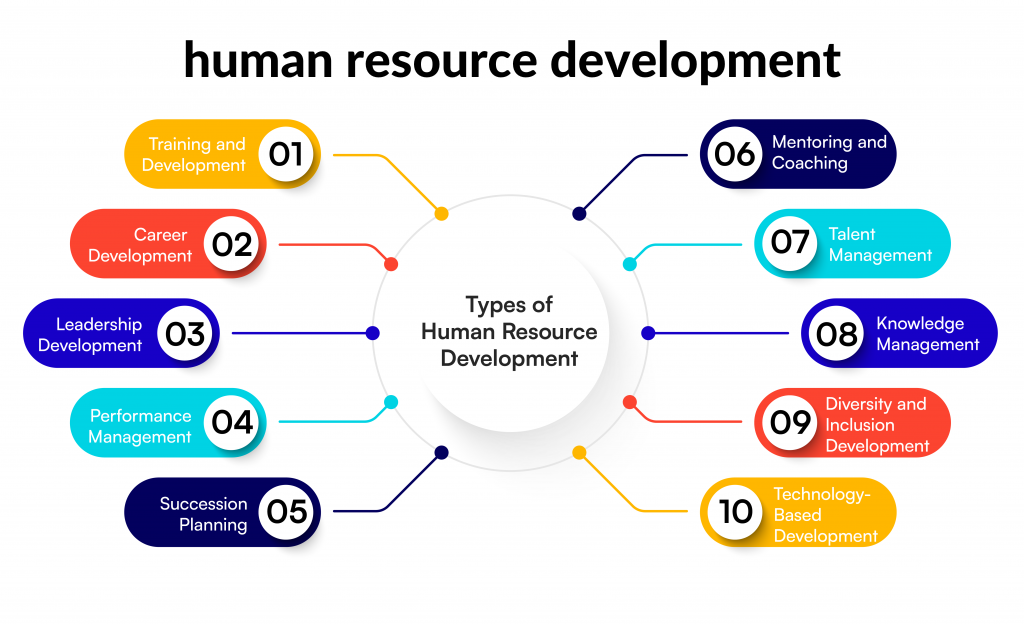Human Resource Development (HRD) is a crucial part of any organization that focuses on improving employee skills, knowledge, and overall performance. It benefits employees and companies by fostering growth and productivity. This guide explains HRD in simple terms so anyone, even a 10-year-old, can understand it.
What Does Human Resource Development Mean?
Human Resource Development (HRD) means helping employees learn new skills, improve their current abilities, and grow professionally. It involves providing opportunities like training sessions, workshops, or mentorship programs to help employees do their jobs better and feel more confident in their roles.
HRD is not just about work skills; it also focuses on personal development. This includes teaching employees leadership qualities, communication skills, and teamwork abilities. In simple words, HRD is like giving employees tools and guidance to succeed and help the company succeed too.
Why Is Human Resource Development Important?
HRD is important because it helps employees and organizations reach their full potential. Here’s why:
- Improves Employee Performance: Employees learn new skills, making them more efficient at their jobs.
- Boosts Confidence: When people feel capable, they are more confident and motivated.
- Increases Company Success: Skilled employees contribute to higher productivity and better results.
- Builds a Positive Work Culture: Offering learning opportunities shows employees that the company cares about their growth.
When employees grow, the entire company grows. HRD ensures everyone is prepared for challenges and future opportunities.
Types of Human Resource Development
HRD includes several methods to help employees learn and grow. These methods are designed to meet different needs and goals:

Training Programs
Training programs are structured learning sessions where employees gain new knowledge. For example, a customer service team might attend a workshop on handling complaints. These programs focus on specific skills that employees need to improve their performance.
On-the-Job Learning
This type of HRD happens while employees are doing their regular work. It includes learning by observing others, trying new tasks, or receiving guidance from a mentor. On-the-job learning is practical and directly applies to the employee’s role.
Career Planning
Career planning helps employees map out their future in the company. It involves setting goals, identifying skills they need to achieve those goals, and creating a plan for their growth. This shows employees that the company is invested in their long-term success.
Here’s an example of a Bio Table for Human Resource Development (HRD):
| Category | Details |
|---|---|
| Title | Human Resource Development (HRD) |
| Definition | HRD is the process of improving employees’ skills, knowledge, and capabilities through various learning programs and experiences. |
| Importance | HRD boosts employee performance, increases company productivity, enhances employee morale, and fosters a positive work culture. |
| Key Components | Training programs, On-the-job learning, Career planning, Mentorship, Leadership development. |
| Benefits to Employees | Skill enhancement, career growth, job satisfaction, confidence building, better job opportunities. |
| Benefits to Companies | Increased productivity, higher employee retention, improved teamwork, innovation, and competitive advantage. |
| Types of HRD | 1. Training programs 2. On-the-job learning 3. Career planning 4. Mentorship and coaching |
| Steps for Implementation | 1. Assess employee needs 2. Design tailored programs 3. Implement HRD activities 4. Evaluate and improve |
| Examples of HRD | 1. Time management workshops 2. Leadership training programs 3. Mentorship programs for career growth |
| Future of HRD | HRD will continue to evolve with technology, ensuring employees stay competitive and adaptable in changing industries. |
| Bottom Line | HRD creates a symbiotic relationship between employees and employers, driving growth, development, and success for both parties. |
Let me know if you need any more modifications or details!
How HRD Benefits Employees and Companies
HRD has many benefits for both employees and companies:
- For Employees:
- They feel more valued and appreciated.
- They gain new skills, which can lead to promotions or better opportunities.
- Their work becomes more fulfilling and meaningful.
- For Companies:
- Skilled employees lead to higher productivity and efficiency.
- A motivated workforce reduces turnover rates.
- Innovation increases as employees bring fresh ideas to the table.
HRD creates a win-win situation where employees and companies grow together.
Steps to Start HRD in a Company
Introducing HRD in a company involves a few simple steps:
- Identify Needs: Determine what skills or knowledge employees need to improve.
- Design Programs: Create workshops, training sessions, or mentorship plans tailored to these needs.
- Implement: Put the programs into action, ensuring employees have access to the right resources.
- Evaluate: Measure the success of HRD programs and make improvements as needed.
Each step is crucial for making HRD effective and meaningful.
Examples of HRD in Real Life

Assess Needs
Imagine a company noticing that employees struggle with time management. They assess the situation and decide to create a program to help employees prioritize tasks.
Create Programs
The company organizes a time management workshop where employees learn tips and tools to manage their workload better.
Track Progress
After the workshop, the company tracks how well employees apply what they learned. They might use surveys or performance reviews to measure improvement.
These examples show how HRD can address real problems and deliver real results.
How Can HRD Shape the Future?
HRD prepares companies and employees for the future. As technology evolves, new skills will be needed. HRD ensures that employees stay updated with the latest trends and technologies, keeping the company competitive.
It also promotes adaptability, encouraging employees to embrace change rather than fear it. In a world that’s constantly changing, HRD acts as a bridge to the future.
The Bottom Line
Human Resource Development is more than just training employees; it’s about empowering them to succeed and grow. It benefits individuals by boosting their skills and confidence, while also helping companies achieve greater success.
By focusing on HRD, companies create a supportive environment where employees feel valued and motivated to give their best. Whether through training programs, career planning, or on-the-job learning, HRD is a powerful tool for shaping a brighter future.


















Got a Questions?
Find us on Socials or Contact us and we’ll get back to you as soon as possible.